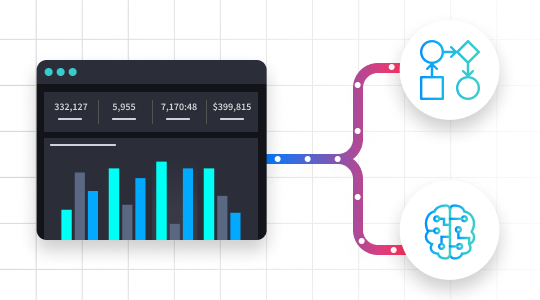Understanding Security Automation vs. Orchestration: What’s the Difference?
Security automation focuses on making individual security tasks run on their own, like automatically blocking a known malicious IP address. Security orchestration, on the other hand, connects and coordinates multiple automated tasks and security tools to work together in a streamlined workflow, like responding to a multi-stage cyberattack. Think of automation as a single musician playing an instrument, while orchestration is the conductor leading the entire orchestra.
In security operations, sometimes seconds can mean the difference between containment and catastrophe. Security teams are under relentless pressure to do more, faster. Enter the security automation and security orchestration. But what do they really mean? While they’re related and often used together, they represent distinct concepts crucial for a robust security posture. Understanding their differences and synergies is key to building a resilient and effective Security Operations Center (SOC).
What is Security Automation?
Security automation refers to the use of technology to perform specific, often repetitive, security tasks without human intervention. Think of it as putting individual security processes on autopilot. This can include a wide range of activities designed to speed up detection, analysis, and response to common security events. Examples of tasks well-suited for security automation include:
- Phishing Triage: Automatically analyzing suspected phishing techniques, checking for malicious links or attachments, and even quarantining them.
- Malware Scans: Initiating automated scans of suspicious files or endpoints upon detection.
- Vulnerability Response: Regularly and automatically scanning systems and applications for known vulnerabilities.
What is Security Orchestration?
Security orchestration takes automation a step further. It’s about coordinating and managing multiple automated tasks and security tools across different systems to execute a complete, end-to-end security workflow or process. If automation handles individual instruments, orchestration conducts the entire symphony.
Orchestration connects disparate security tools and ensures they work together harmoniously. Examples of security orchestration in action include:
- Incident Escalation: Automatically escalating verified critical incidents to the appropriate response teams, including creating tickets in an IT service management system.
- Cross-Platform Ticketing: Integrating various security tools (e.g., SIEM, EDR, vulnerability scanners) with ticketing systems to ensure seamless information flow and tracking of incidents across platforms.
- Multi-Tool Integrations for Complex Response: Coordinating actions across multiple security tools for a comprehensive response. For instance, upon detecting a compromised endpoint, orchestration could trigger the EDR to isolate the host, the firewall to block malicious IPs, and the identity management system to disable the user’s account.
Orchestration Needs a System of Record
Effective security orchestration relies on a centralized platform that can serve as a single source of truth and a command center for all security operations—a system of record. This system not only automates individual steps but operationalizes the entire orchestration strategy, providing visibility, control, and a comprehensive audit trail for all actions taken.
Swimlane Turbine is an AI automation platform designed to be this system of record. It moves beyond simple task automation to enable true security orchestration by unifying security tools, teams, and telemetry. Turbine empowers security professionals to build, manage, and monitor complex security workflows, ensuring that all components of your security infrastructure work in concert to achieve desired outcomes. It operationalizes orchestration by providing a robust framework for defining, executing, and refining security processes across the entire organization.
3 Main Differences Between Automation vs. Orchestration
While both aim to improve security operations, automation and orchestration diverge in scope, focus, and how they contribute to a layered defense strategy. They are not mutually exclusive; in fact, orchestration often relies on underlying automated tasks.
1. Task vs. Workflow
- Automation: Focuses on individual, discrete tasks. For example, automating the detonation of a suspicious attachment in a sandbox.
- Orchestration: Focuses on coordinating a series of automated (and sometimes manual) tasks to complete an entire workflow or process. For example, orchestrating the entire phishing response workflow, from initial email analysis (automation) to ticket creation, user notification, and IoC blocking across multiple security tools (orchestration).
2. Speed vs. Strategy
- Automation: Primarily delivers speed and efficiency for specific actions. Its goal is to execute known, repetitive tasks faster and more reliably than a human could.
- Orchestration: Focuses on the strategic coordination of these automated tasks to achieve a broader security objective. It’s about ensuring the right actions happen in the right order, involving the right tools and people, to effectively manage an incident or process from start to finish.
3. Tool-Specific vs. Tool-Agnostic Coordination
- Automation: Can often be tool-specific, like automating a function within a particular EDR solution or firewall.
- Orchestration: Is inherently tool-agnostic and focuses on coordinating actions across multiple, often disparate, security tools and platforms. It ensures that your SIEM, EDR, threat intelligence platforms, ticketing systems, and other solutions can communicate and work together seamlessly.
Why You Need Security Automation and Orchestration in Modern Security Operations
With highly sophisticated and high-volume cyber threats happening every day, relying on manual processes or isolated automation is no longer sufficient. Modern security operations require both the efficiency of automation and the strategic coordination of orchestration to build a resilient and adaptive defense.
The synergy between automation and orchestration is powerful:
- Automation Powers Orchestration: Individual automated tasks are the building blocks that orchestration uses to construct comprehensive security workflows. Without robust automation of specific actions, orchestration cannot achieve its full potential.
- Orchestration Drives End-to-End Visibility and Control: Orchestration provides the bigger picture, connecting the dots between various automated tasks and security tools. This gives security teams end-to-end visibility into their processes and allows for more strategic decision-making and control over incident response and other security operations.
- Layered Defense: Together, they enable a layered defense strategy where automated tasks handle the frontline responses and initial analyses, while orchestration ensures these actions are part of a coordinated, multi-tool defense that can adapt to complex threats.
- Improved Mean Time to Detect (MTTD) and Mean Time to Respond (MTTR): Automation speeds up individual steps, and orchestration streamlines the entire process, significantly reducing the time it takes to detect and respond to incidents.
How Swimlane Turbine Brings Automation and Orchestration Together
Swimlane Turbine is an AI automation platform meticulously designed to bridge the gap between automation and orchestration, offering a unified solution for modern security operations. It empowers security teams to leverage both capabilities effectively through several key features:
- Turbine Canvas
Swimlane Turbine’s visual, low-code builder empowers analysts to design and deploy automation workflows with ease. With Turbine Canvas, anyone on the team can drag, drop, and connect logic to automate tasks and orchestrate processes—no heavy coding required. - Hero AI
Built into the platform, Hero AI enhances decision-making with advanced, context-aware intelligence. From dynamic response recommendations to AI-augmented reporting, Hero AI helps analysts work faster, smarter, and more effectively in high-pressure moments. - Autonomous Integrations
Turbine integrates with any REST API to connect siloed tools and build an ecosystem-agnostic automation network. With reusable connectors, you can standardize business logic across playbooks, ensuring consistent action across your entire security stack. - Business Intelligence Applications
Go beyond the SOC. Turbine delivers visibility into processes across SecOps, fraud, OT, cloud, compliance, audit, and more. With built-in case management, you can streamline investigations and save time customizing real-time reports and dashboards for any stakeholder. - Active Sensing Fabric
Powering the core of Swimlane Turbine, the Active Sensing Fabric ingests millions of alerts per day and applies custom enrichment to each event. This ensures high-throughput, scalable automation that’s driven by your unique business logic—not generic templates.
By combining these features, Swimlane Turbine provides AI automation to intelligently orchestrate workflows, enabling security teams to respond faster, more efficiently, and more strategically to the full spectrum of security challenges.
Democratizing Automation Beyond the SOC
The power of automation and orchestration, as embodied in platforms like Swimlane Turbine, extends far beyond the traditional SOC. The ability to streamline processes, ensure consistency, and improve efficiency has broad applications across various business functions:
- Legal Hold: Automating the identification, preservation, and collection of data relevant to legal matters, ensuring compliance and reducing manual effort for legal teams.
- Compliance Management: Orchestrating tasks related to evidence gathering, audit logging, and reporting for various regulatory requirements (e.g., GDPR, HIPAA, SOC 2), ensuring continuous compliance and reducing the risk of penalties.
- Fraud Prevention: Automating the detection of suspicious activities, enriching alerts with contextual data, and orchestrating response workflows to investigate and mitigate potential fraud in real-time.
- Employee Onboarding/Offboarding: Orchestrating the numerous IT and security tasks involved in onboarding new employees (e.g., account creation, access provisioning) and offboarding departing ones (e.g., disabling accounts, revoking access, preserving data), ensuring security and efficiency.
- IT Operations: Automating routine IT tasks such as server patching, system diagnostics, and service request fulfillment, freeing up IT staff to focus on more complex issues.
By democratizing access to powerful automation and orchestration capabilities, platforms like Swimlane Turbine enable organizations to enhance productivity, reduce risk, and improve operational excellence across a multitude of departments and use cases.
Ready to see how Swimlane Turbine can revolutionize your security operations and beyond? Request a demo today to experience the power of AI automation and orchestration.
TL;DR: Security Automation vs. Orchestration
Security automation handles individual, repetitive security tasks automatically (e.g., scanning files), while security orchestration coordinates multiple automated tasks and tools into complete workflows (e.g., full phishing response). Automation focuses on task speed, and orchestration on strategic workflow across different tools. Modern security needs both: automation for efficiency in specific actions, and orchestration to connect these actions into a cohesive, strategic defense, improving overall detection and response times. Platforms like Swimlane Turbine provide a system of record to build and manage both automation and complex orchestrated workflows.

Swimlane Turbine Demo
See how Swimlane Turbine can help you and your SecOps team hyperautomate by requesting a demo below


